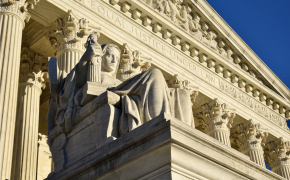2024 Litigation Look Ahead Series: Increased Application of Major Questions Doctrine Could Limit Regulatory Authority
B&D is pleased to present the next installment of our 2024 Litigation Look Ahead series. (Read part one covering the future of Chevron deference here.) In this edition, our litigation team highlights recently decided or pending appellate court cases examining the major questions doctrine and the scope of regulatory authority. These cases, which could end up before the U.S. Supreme Court, will affect how courts address future challenges to environmental regulations, potentially making it easier to dispute agency rulemakings.
North Carolina Coastal Fisheries Reform Group v. Capt. Gaston LLC, No. 21-2184
Case Summary
In this case, the plaintiff, North Carolina Coastal Fisheries Reform Group, sued shrimp trawlers operating in North Carolina’s Pamlico Sound for allegedly violating the Clean Water Act (CWA) by engaging in unpermitted activity. They argued that throwing bycatch overboard was a “discharge of a pollutant” requiring a National Pollutant Discharge Elimination System permit from the U.S. Environmental Protection Agency (EPA) and that trawl nets’ disturbance of sediment was considered an “excavation” requiring a Section 404 permit from the Army Corps of Engineers.
On August 7, 2023, the U.S. Court of Appeals for the Fourth Circuit affirmed a lower court decision that the North Carolina Coastal Fisheries Reform Group failed to plausibly allege that shrimp trawlers violated the CWA. In doing so, the court invoked the major questions doctrine, a powerful, relatively new principle elucidated by the recent U.S. Supreme Court case West Virginia v. EPA (2022). Find B&D's thorough analysis of the West Virginia decision and its impacts here.
Quoting West Virginia, the Court of Appeals explained that in “extraordinary cases” involving interpretive questions of vast “economic and political significance,” a clear statement of congressional authorization for the agency’s action is required (this reasoning is referred to as the major questions doctrine). In its opinion, the Fourth Circuit identified several factors to consider when evaluating whether agency action implicates a “major question”: “when the Act’s structure indicates that Congress did not mean to regulate the issue in the way claimed”; where “there is a different ‘distinct regulatory scheme’ already in place to deal with the issue which would conflict with the agency’s newly asserted authority”; where the agency had failed to invoke the newly asserted authority previously; when the asserted authority raises federalism concerns; and “when the asserted authority falls outside the agency’s traditional expertise.” North Carolina Coastal Fisheries Reform Group v. Capt. Gaston LLC, 76 F.4th 291, 297 (2023) (citations omitted). Applying these factors to the case, the Court of Appeals first determined that the major questions doctrine applied, primarily because EPA regulation of the discharge of bycatch to state waters would have “significant political and economic consequences” and would represent a vast expansion of EPA’s regulatory authority.
The court then analyzed the CWA and concluded that the statute did not set forth “clear congressional authorization” for the EPA to regulate the release of bycatch to state waters. The CWA’s use of the “expansive” and vague term “biological materials” in its definition of “pollution” is not sufficient to demonstrate that Congress intended to delegate such authority to EPA. Also, the court said, a “distinct regulatory scheme” already exists under the Magnuson-Stevens Act that grants states primary authority over state waters. Additionally, requiring a permit for the release of bycatch to state waters would raise federalism issues and cause widespread economic impacts throughout the country.
Implications
The major questions doctrine has been expanded in recent years. On the heels of the West Virginia decision, the Supreme Court invoked the doctrine in concluding that the Biden Administration’s plan to forgive $430 billion of federal student loans was a “major question” lacking clear statutory authorization. Fisheries Reform Group illustrates how, in the post-West Virginia world, lower courts are invoking this doctrine more frequently as a basis for limiting federal agency regulatory authority when the issue(s) presented potentially implicate significant political and economic concerns.
This shift could have a significant impact on environmental litigation involving agency regulatory actions, as agencies frequently rely on statutes originally enacted decades ago to address problems that were not recognized or considered when the legislation was initially adopted. Modern agency interpretations, formulated to meet today’s environmental challenges, may not clearly or fully align with existing statutory text, inviting application of the major questions doctrine.
Texas v. NRC, No. 21-60743
Case Summary
A petition for rehearing en banc is currently pending for an August 25, 2023 decision by the U.S. Court of Appeals for the Fifth Circuit, which vacated a U.S. Nuclear Regulatory Commission (NRC) license granted to Interim Storage Partners to build and operate a consolidated interim storage facility for commercial spent nuclear fuel in Texas. In that ruling, the Fifth Circuit held that NRC did not have the authority under the Atomic Energy Act (AEA) to issue licenses for private parties to store spent nuclear fuel away from the reactor site, because “the Nuclear Waste Policy Act (NWPA) creates a comprehensive statutory scheme for addressing spent nuclear fuel accumulation…” and private offsite storage of spent nuclear fuel is contrary to Congressional policy expressed in the statute.
The NWPA plainly and unambiguously provides that, “until there’s a permanent repository, spent nuclear fuel is to be stored onsite at-the-reactor or in a federal facility.” The Fifth Circuit relied on the plain language of the AEA and NWPA, though it also invoked the major questions doctrine to reinforce its view that NRC lacked legal authority to issue the license. Judge Ho explained that the disposal of nuclear waste was an issue of great economic and political significance; as such, the court would not defer to NRC’s interpretation of the AEA’s licensing provisions. Under West Virginia, questions of “such magnitude and consequence” are reserved for Congress or an agency acting pursuant to clear delegation from Congress.
Implications
This decision creates a federal circuit court split between the U.S. Court of Appeals for the District of Columbia Circuit’s ruling in Bullcreek v. Nuclear Regulatory Commission and the U.S. Court of Appeals for the Tenth Circuit decision in Skull Valley Band v. Nielson, which may prompt Supreme Court review. As with North Carolina Coastal Fisheries Reform Group, referenced above, Texas v. NRC illustrates how the relatively novel major questions doctrine is being applied more frequently by federal courts to curtail agency authority in the face of statutory ambiguity. The decision could also significantly impact the licensing of private, offsite reactor spent fuel storage facilities, if the Fifth Circuit’s interpretation of the licensing provisions of the AEC stands.
Texas v. EPA, No. 22-1031
Case Summary
In 2021, EPA finalized greenhouse gas emissions standards for light-duty vehicles for model years 2023 through 2026 (the 2021 Rule), replacing a less-stringent Safer Affordable Fuel-Efficient Vehicle Rule. Pursuant to section 202(a) of the Clean Air Act (CAA), EPA is required to establish standards for emissions of air pollutants from new motor vehicles that cause or contribute to air pollution that is anticipated to endanger public health.
In 2022, 15 states, including Texas, filed a petition for review of the standards in the U.S. Court of Appeals for the D.C. Circuit.
In their petition, the states argue the 2021 rule runs afoul of the major questions doctrine because the CAA does not authorize EPA to require vehicle manufacturers to produce more electric vehicles and “threaten the reliability of the electric grid[.]” In addition, the states argue the 2021 rule is arbitrary and capricious due to flawed “social cost” analysis of greenhouse gas estimates in relation to potential national security concerns. Oral arguments took place on September 14, 2023. The decision is pending.
Implications
The court’s ruling could impede the implementation of EPA’s proposal to dramatically cut emissions from model year 2027 cars and light trucks. A determination that EPA’s greenhouse gas emissions standards implicate the major questions doctrine could invite similar challenges to other technology-forcing standards and regulations under major environmental statutes, a trend that would have far-reaching impacts on the move towards electrification of vehicles and beyond.
In Conclusion
Successful invocation of the major questions doctrine in these and other cases challenging environmental and other kinds of regulatory actions will significantly affect the scope of future litigation. Regulatory agencies relying on decades-old statutes may see their modern rulemakings more frequently challenged as courts question long-standing administrative interpretations of arguably ambiguous statutes. This retroactive judicial review of regulations years after they were finalized could create an unstable regulatory environment. Congress must attempt to speak even more clearly with respect to its intended limits on regulatory agency authority when drafting statutes - no small challenge for a closely divided Congress.
Coming Soon in our Litigation Look Ahead Series…
In our 2024 Litigation Look Ahead series, we highlight cases – environmental and otherwise – that could have notable impacts on the regulated community or lead to changed regulatory approaches. Upcoming installments of the series will examine the constitutionality of appointed administrative law judges, the judicial review process of Administrative Procedure Act actions, Fifth Amendment takings, the Comprehensive Environmental Response, Compensation, and Liability Act (CERCLA), and natural resource law. In case you missed it, read part one of the series, covering the future of Chevron deference.
B&D’s litigators are actively involved in and monitor cases in courts nationwide. With decades of experience in toxic torts, class actions, Superfund and site remediation, enforcement defense, regulatory challenges, and business and contract disputes, our litigation team is well-equipped to handle diverse legal matters.











